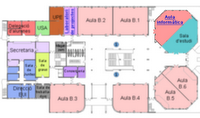Marks will be available in a few days in this same site as an update of this post.
Update: Exam marks are available in the same link as the attendance pages. Please note that solved exam contained a couple of errors that have been now fixed, just download a fresh version.
Second Update: It seems that some of you have trouble doing the math to know your current score, so now you have that numbers on the mark's page. I repeat what I explained the first day of class and it is detailed in Chapter0 slides.
mark(%) = attendance*10/classes + (9-assignments)*exam/10 + assignments*10 + labThe underlying logic is that exam only accounts for 70% of the final mark if you pass two assignments, 80% if you pass one assignment or 90% if you did not pass (or did not turn in) any assignment. Also note that failing on an assignment has not any negative effect on your score.
The same logic will be applied to the second term marking and then, both marks will be averaged to obtain your final grade.
Please remember the pass mark is 50%, so if you score less than this you will have to work harder on the second term to pass the subject.
Lab exam is still being marked so it has not yet been accounted for.
Third Update: Now the lab mark has been included. Go and check yours!







